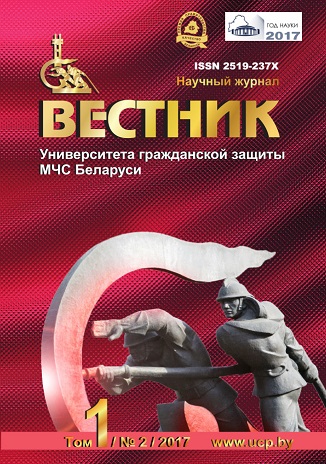Экспериментальные исследования пожарного ствола СПРУК 50/0,7 «Викинг» при подаче воды
DOI:
https://doi.org/10.33408/2519-237X.2017.1-2.159Ключевые слова:
пожарный ствол, гидродинамические параметры, карта орошения, средняя интенсивность орошенияАннотация
Приведены результаты экспериментальных исследований гидродинамических параметров пожарного ствола СПРУК 50/0,7 «Викинг»: расхода огнетушащего вещества, дальности подачи огнетушащего вещества, эффективной дальности распыленной струи огнетушащего вещества и средней интенсивности орошения.
Библиографические ссылки
Fire barrel, manual, universal SPRU 50/0,7. Passport. Manual. EFUIP 306142.001 RE. - M: RUE «Instrument-Making Plant» OPTRON». 9 p. (rus)
Shafranskiy D.A. On the results of testing the experimental sample of the barrel of a manual fire-fighting universal SPRU 50/0,7. Vestnik Komandno-inzhenernogo instituta MChS Respubliki Belarus’. 2013. № 1 (17). Pp. 68-74.(rus)
Karpenchuk I.V., Shafranskiy D.A., Yankevich N.G Development and optimization of hydrodynamic parameters of the domestic modification of the experimental model of the manual fireman's trunk. Vestnik Komandno-inzhenernogo instituta MChS Respubliki Belarus’. 2013. № 2 (18). Pp. 270-279. (rus)
Kamlyuk A.N., Parmon V.V., Morozov A.A. Calculation and optimization of the geometry of the flow channel of the fire barrel at a flow rate of up to 5 l/s. Vestnik Komandno-inzhenernogo instituta MChS Respubliki Belarus’. 2016. № 1 (23). Pp. 51-59. (rus)
Fire barrel manual universal SPRUK 50/0,7 «Viking». Passport. Manual. EFUIP 306142.001 RE. M: RUE «Instrument-Making Plant» OPTRON». 9 p. (rus)
Fire safety standards system. Fire fighting trunks manual. General specifications: STB 11.13.14-2009. Enter. 21.08.09. M: Gosstandart of the Republic of Belarus Belarus: Establishment «Minsk regional department of the Ministry of Emergency Situations of the Republic of Belarussia», 2009. 12 p. (rus)
Bokhan N.I. and others. Teaching-methodological manual on the processing of experimental data. Light Grove: IPPK MChS Respubliki Belarus’, 2008. 34 p. (rus)
Stvoly pozharnye ruchnye RSP-50, RSK-50 DSTU 2112-92 (GOST 9923-93) passport. Khartsyz, Ukraina: OOO «Khartsyzskiy mashinostroitel'nyy zavod». 6 p.
Опубликован
Как цитировать
Лицензия
Все права защищены (c) 2017 Пармон В.В., Камлюк А.Н., Волчек Я.С., Асилбейли Р.Р., Морозов А.А.
CC «Attribution-NonCommercial» («Атрибуция — Некоммерческое использование») 4.0




















